Ayur Jyotish Sketches in Astrological Longevity by Robert A. Koch
Article By Robert A. Koch
Bhagavan Sri Krisna said: Time I am, the great destroyer of the worlds, and I have come here to destroy all people. With the exception of you [the Pandavas], all the soldiers here on both sides will be slain.
— Bhagavad-Gita 11.32
Time and tide wait for no man’ is a familiar English adage, yet its meaning has a much broader application in light of the principles of the above verse from Bhagavad-gita. The statements of Sri Krsna indicate that the indelible and irrefutable processes of birth and death are carried out entirely by the will of God, and His will is that in this world everyone must die at a particular place, in a particular manner, and at a specific time.
In Jyotish, we can get a glimpse into the workings of man’s longevity and the destiny, which requires him to come and go from this world not by his own choosing, but by Divine Will only. Longevity is granted in such finite terms, that one can live as long as he can take a pre-determined number of breaths throughout the course of a lifetime. Grahas and yogas in the astrological chart enable the astrologer to map the term of lifespan, while dasha periods will time the event of death. While the mandates of such destiny are impossible to overrule, the good karmas of the native are the only factor that may grant him an extension of the term of life. Still, who gets a ‘promotion,’ and who doesn’t, is still a matter of Divine Will and such exceptions are beyond the scope of astrological calculation. As pertains that which can be determined within the scope of Jyotish, the following guidelines will be useful in determining longevity.
Determination of Lifespan in Jyotish
In Chapter 11 of the Bhagavad-gita, the Virata Purusha, or universal form of Vishnu, is described in detail.Virata means ‘large’ or ‘huge,’ thus indicating that the Virata Purusha is a form encompassing the entire manifested universe. The Virata Purusha is also called Kala Purusha, as this gigantic form of Vishnu encompasses the three dimensions of space, plus the fourth dimension, time (Kala). Time is defined as a linear progression of the state of being, as well as infinite repetitions of various cycles and sub-cycles. With regard to the planet Earth, time is defined in terms of a samvatsara, which is the period of sidereal progression of the Sun through the signs of the zodiac. The Sun is the natural Atmakaraka, and its symbolic zodiacal movement at a rate of 1° of arc per year is the basis of lifespan determination in Jyotish.
Terms of Lifespan
Before venturing to time the death of the native, the term of longevity must be established first. The maximum term of longevity for human beings in the Kali-yuga, viz. 120 years, is thus symbolized by the Sun’s movement through each of three Gandantas, or life-terminating zones of the naksatra belt. Progressing the Sun at the rate of 1° per year, 120 years is reached at the junction between Ashlesha and Magha; then again between Jyeshta and Mula; and finally between Revati and Aswini. These are Gandantas, or life-terminating naksatra padas.
In Jyotish, the lifespan is first assigned as short, medium, or long term, which may be determined by way of various Ayur yogas as explained in the next section. If 120 years is the maximum longevity (and which is the maximum number of years contributed to the lifespan in the Vimsottari dasa system), then short life (Alpayu) a maximum of 40 years; medium life (Madhyayu) gives a maximum of 80 years; and full life would grant 120 years. Different contributions of years to the lifespan are offered through other dasa systems, however, and thus three different versions of short, medium, and long life are considered. According to Shoola dasa and Ashtottari dasa, the maximum planetary contribution of years to the lifespan is 108; while, according to Sthira dasa, the maximum contribution of years comes to 96. Thus the breakdown of three differing terms, according to different dasa systems, may be studied as follows:
Tables of Longevity Terms per Dashas
| Range of Longevity Based on Dashas | |||
| Ayus (term) | Sthira dasha
(96 years) |
Ashtottari/Shoola dasha (108 years) | Vimsottari dasha
(120 years) |
| One third of dasha | 96/3 = 32 years | 108/3 = 36 years | 120/3 = 40 years |
| Alpa (short) | 0 to 32 years | 0 to 36 years | 0 to 40 years |
| Madhya (medium) | 32 to 64 years | 36 to 72 years | 40 to 80 years |
| Purna (long) | 64 to 96 years | 72 to 108 years | 80 to 120 years |
The average term of longevity is the one based on Ashtottari dasa and Shoola dasa, and this applies to the number of Navamsas within the 12 zodiacal signs. By progressing the lagna, for example, at a rate of 1 Navamsa (3°20’ or arc) = 1 year, the first naksatra Gandanta will be reached at the age of 36, or the first term of longevity per Shoola dasa. Because Shoola dasa and the theme of Navamsa progressions are the most effective in determining the death of the native, the average term of longevity will be considered in the chart illustrations shown later in this article.
Ayur Yogas
Which of the three variations of short, medium, and long life may be used for a particular horoscope can be determined by way of a variety of Ayur yogas in Jyotish. There are many of these suggested in the classical literatures, but in practice the most useful and effective of these involves various sets of longevity factors. Although there are many combinations giving differing terms of longevity, three methods given as follows will be studied in this article:
First Method – Three Key Longevity Factors: lagna, 10th house/lord, and 8th house/lord
A useful way of getting a snapshot view of the term of longevity is a determination of the strengths of the lagna and its lord, the 10th house and its lord; as well as the 8th house and its lord. Strengths in this context may be used as per Shad-balas, as well as according to specific criteria that will be given shortly. In order to understand the importance of these houses relating to longevity, one may consider the symbolism of the natural zodiac: Saturn is the karaka of the 8th house, he owns the natural 10th house, and is debilitated in the first house; Mars owns the natural 1st and 8th houses, and is exalted in the 10th house. The Sun is the natural karaka of the 1st and 10th houses, and owns the 5th house. The Sun is also the natural Atmakaraka planet. Thus, in some texts, the 5th house and its lord are substituted for the 10th lord, although in this study, we shall consider the 10th lord mainly. The strengths of the lords of these houses will be determined according to the following criteria:
- If the lord is in a Kendra, Panapara, or Apoklima (angular, succedent, or cadent) houses, the term is long, medium, or short respectively;
- If the lord is friendly, neutral, or inimical to the Sun, the term will be long, medium, or short respectively;
- If the lord is in a sign of a friend, neutral, or enemy, the term will be long, medium, or short respectively. Maximum strength is exaltation, whereas minimum strength is debilitation; and,
- If the lord is in a Navamsa of a friend, neutral, or enemy, the term will be long, medium, or short respectively. Exaltation gives maximum strength, while debilitation gives the minimum.
Considerations of Planetary and House Strengths (Graha and Bhava balas)
The strengths of these planets should be considered not only in terms of Shad-bala, but according to four sources of strengths given by Maharshi Jaimini in his Upadesha sutras.
Specifically, for purposes of longevity calculation, the first source of strength for signs/houses is considered. For all other purposes coming under the heading of Phalita (results of karmas), the fourth source of strength according to Jaimini may be used. In hierarchical order (strongest to weakest), these are listed as follows:
First Source of Strength – Ayur Calculations
- The first source of strength is the presence of the Atmakaraka planet in a sign.
- If the AK is not present in a sign, then a larger number of planets in the sign renders it stronger;
- If both signs have an equal number of planets, then the presence of exalted planets renders the sign stronger and debilitated planets renders it weaker.
- If both signs are still equally strong, then the natural strengths of signs may be considered: Dual>Fixed>Moveable (strongest to weakest respectively);
- If both signs are unoccupied, then the one ruled by the AK planet is strongest;
- If neither sign is ruled by the AK, then the one whose lord is highest in degrees in its sign is the stronger.
- If the two signs have the same lord, or if the lords have equal longitude, then odd signs are strong if the lord is in an even sign; and even signs are strong if their lords are in an odd sign.
Additional Considerations of Strengths
Other essential elements of interpretations will reveal strengths of planets as well. For example, the combination of multiple malefics weakens planets, whereas association/aspect of benefic planets strengthens them. Retrograde and debilitated malefics in Kendras gain strength, whereas retrograde and exalted benefics in Kendras becomes weakened. Planets entangled in Sarpa yoga (three of four malefics in Kendra to them) also becomes weakened, whereas shubha-kartari yoga of benefics strengthens them. Parivartana yoga of the lagna lord and 8th lord is damaging for longevity, especially if Saturn is the lord of the 8th.
- Finally, affliction to the luminaries by malefics, especially Rahu and Ketu, diminishes health and longevity of the native.
Second Method – Three Pairs of Longevity Factors
This system of three pairs of longevity factors seems to acquire the most emphasis by both Parasara and Jaimini, and in practice, it is found to be the most consistently accurate and useful. The three factors being considered are as follows:
- The signs occupied by the lords of the 1st and lord of the 8th;
- The signs occupied by the Hora lagna and the lagna; and,
- The signs occupied by Saturn and the Moon
Consider the nature of the signs occupied by each of these pairs. If both factors in a pair occupy the same sign type, then the longevity granted is as per the following:
- Moveable signs = long life;
- Fixed signs = short life; and,
- Dual signs = medium life
If the natures of the occupied signs are different, then choose the term granted by the third pair. For example, if one factor in a pair grants long life, whereas the other grants medium life, then the third factor, i.e. short life will be given. Or, if one factor grants long life, and the other factor grants short life, then the third factor, viz. medium life is the term granted for that pair of factors.
- The majority consensus of the term of longevity granted by all three pairs will be the term of final longevity given to the native.
- If all three pairs yield a different term, then take the term, which is granted by the lagna and Hora lagna.
- If the Moon is in the 1st or 7th house of the chart, then take the term granted by Saturn and the Moon.
Increase or Decrease in the Term of Longevity (Kaksha vriddhi and Kaksha Hrasa)
Certain factors in the horoscope may increase or decrease the final term as granted by the system of three pairs, and there are a variety of opinions among astrological authorities on this subject. For purposes of simplicity, the following may be noted:
- Increase in the term of longevity (Kaksha Vriddhi) occurs if a strong and unafflicted Jupiter is in the ascendant or 7th house;
- Benefics in trines or which caused Shubakartari yoga of the 1st or 7th houses from the lagna or Chara Atmakaraka, cause Kaksha Vriddhi;
- Benefics in kendras, while malefics are in 3rd, 6th, or 11th houses, increases the longevity term; or,
- Benefics in the 8th house or conjoining the 8th
- Decrease in the term of longevity (Kaksha Hrasa) occurs if Saturn conjoins or aspects the planets/signs contributing to the longevity determination. This, however, will not occur if Saturn is one of the planets itself. Also, if Saturn is in its own or exaltation sign, decrease in the longevity term does not occur.
- Multiple malefics in the 8th house from lagna or the Atmakaraka planet, or conjoining their lords, decrease the term of longevity;
Malefics in trines, or which cause Papakartari yoga of the 1st or 7th houses from the lagna or Atmakaraka, decrease the term of longevity.
Third Method: Three Sets of Longevity Factors: Drekkana, Navamsa, and Dwadasamsa Considerations
Varga positions of the lagna lord, Moon, and 8th lord are also very useful in determining the lifespan. These may be considered as follows:
Drekkana (D-3) chart: In the Drekkana chart, if the Moon and the lagna are both in moveable signs, then the longevity term is long. If one is in a moveable sign, and the other a fixed sign, then the term of longevity is medium; and if one is in a dual sign and the other in a moveable sign, then the term is short. Similarly, if both are in fixed signs, the term is short, whereas if both are in dual signs, the term is medium.
Navamsa (D-9) chart: Consider the same as above for the Navamsa positions, except in this case the Moon sign and the lord of lagna (from the rasi chart). If the Moon is also lord of the lagna, then take the lord of the Moon’s sign.
Dwadasamsa (D-12) chart: Consider the positions of the 1st and 8th lords (of the rasi chart) in the Dwadasamsa chart, according to the above criteria. The consensus of the term of longevity given by these three pairs will grant the final term.
Chart Illustration #1: Death following kidnapping: Example of Alpayu
Female
April 14, 1977
13:46 EST
Cleveland, OH USA
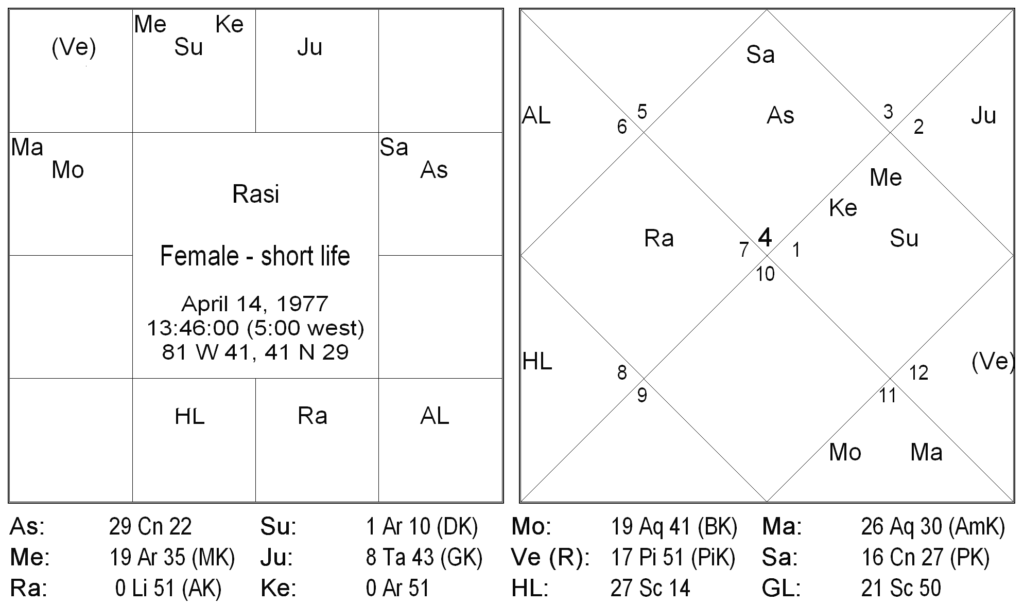
The native died following a kidnapping that occurred on 30th April 2001, although her body was not discovered until 22nd May 2002. The native was thus 34 at the time of her disappearance.
Deciding the Term of Longevity – First Method
In longevity determinations the first task is to decide the term of lifespan of the native, whether it be Alpayu (short, 0 to 36 years); Madhyayu (medium, 36 to 72 years); or long (72 to 108 and beyond).
In the first approach mentioned above, the strengths of 1st, 10th, and 8th lords are considered. Now examine the chart of the native:
1. The lord of the lagna is in the 8th house in a neutral sign, but also associated and aspected by three malefics, Saturn, Rahu and Mars (note that rasi aspects are considered here). This weakens the ascendant lord greatly, thus diminishing longevity.
2. The lord of the 10th house is Mars, who is in an enemy’s sign in the 8th house and also coming under the aspects of Saturn and Rahu. It is thus rendered weak and thereby unable to contribute to the lifespan;
3.The lord of the 8th house is Atmakaraka Rahu, who, although stronger than the others, is also the subject of multiple malefics aspects. Rahu by itself is harmful to the lifespan if in the 4th (8th and 12th also) house. Jupiter’s aspect falls onto Rahu (by rasi drishti), and thus, although the native did not reach the medium term of life, she lived to the upper end of the short term.
Second Method
This is the method of three pairs, which is found to be the most widely acceptable and taught by most authorities. Note the three pairs of longevity factors as follows with respect to this chart:
- Lord of lagna = Moon = fixed sign placement = short life
- Lord of 8th = Rahu = moveable = long life » term is medium
- Hora lagna = Scorpio = Fixed = short life
- Lagna = Cancer = moveable = long life » term is medium
- Moon sign = Aquarius = Fixed = short life
Saturn’s sign = Cancer = Moveable = long life » term is medium
According to three pairs’ assessment, the native should have medium life (36 to 72), but she died at age 34. However, in this chart there is a very clear indication of Kaksha Hrasa (decrease in the term of longevity), as a malefic Saturn occupies one of the longevity factors, namely the lagna. Thus, what starts out to be medium life becomes short life in the final analysis.
Third Method
This approach involves the strengths of: (1) the lagna and Moon in Drekkana chart; (2) the lord of Lagna and Moon in the Navamsa chart; and (3) the lord of lagna and lord of 8th in the Dwadasamsa chart. Note as follows why the native attained only the short term of life:
- In the Drekkana chart, the lagna as well as the Moon are in dual signs. This gives medium life;
- In the Navamsa chart, the Moon occupies a dual sign (Pisces). It is also the lord of rasi (D-1) lagna, and so the lord of the Moon sign (in D-1) is considered for the second factor. It is Rahu, which is placed in a moveable sign (Libra) in Navamsa. Thus, the term granted is short life; and,
- In the Dwadasamsa chart (D-12), the lord of the rasi lagna (Moon) is in a dual sign, whereas the lord of the 8th Rahu is again in a moveable sign. This gives short life. Thus two out of three considerations grant short life to the native.
Timing Death
Once the term of longevity is determined, the next task is to time the point of death of the native. Timing anything in astrology is no easy task, yet some specific guidelines are given by the authors of classical literatures on Jyotish. Although the methods of timing are many, in this article I will confine the focus to the most consistent and accurate methods. These are the Vimsottari dasa, as well as Shoola dasa. Transits of planets also, most notably that of Saturn and Rahu/Ketu, bear significantly into the over-all accuracy of timing death.
Vimsottari dasa
The dasas of Maraka lords, i.e. 2nd and 7th will bring death, but only if their dasas operating during the term of longevity granted. The houses of longevity are the 8th from the lagna, and the 8th from the 8th. Thus, the 12th from these houses – 2nd and 7th – are maraka (death inflicting), as are their lords. The likelihood of their bringing death during their major and sub-periods will depend on their placement and strength, as well as aspects from functionally malefic planets. According to Laghu Parashari Siddhant, the respective order of malfeasance of dashas likely to bring death is as follows:
- The lord of the 2nd or 7th is powerful to bring death;
- Malefic planets occupying either of these houses;
- Malefics associating with the lords of 2nd or 7th;
- Benefics (functional) associating with lords of 2nd or 7th;
- Lords of the 7th or 8th;
- Lords of the 3rd or 8th conjoined with that of the 2nd or 7th;
- Saturn in association with a Maraka;
- Lord of the 6th or 8th, whether or not it is associated with a maraka; and,
- The least powerful planet in the chart
If death does not take place during the dasha periods of the above planets, then it will occur during that of the most powerful malefic in the chart. The lord or occupant of the 12th house will also cause death when the dasas of other maraka lords do not operate.
Transits of Saturn
Saturn, being the chief Ayur karaka, will issue forth death when in transit, providing the following general conditions apply:
- Saturn is moving in the 4th, 8th or 12th house from the natal Moon;
- Saturn is in trines to the Mrtyupada (Arudha of the 8th house), or in the 7th from it or its trines;
- Saturn’s transiting aspect falls onto a planet in Mrtyubhaga;[1]
- Saturn’s transiting aspect falls onto the ascendant or its lord, as well as the sign and lord of the Moon’s placement;
- Saturn in collaboration with other malefics moves over the 8th house of the chart, or afflicts its lord;
- Saturn’s transiting and natal aspects fall onto the 3rd or 8th from the Arudha lagna, as well as 3rd or 8th from the Atmakaraka planet. The effects become all the more powerful when conjunctions or aspects (both natal as well as transiting) of Rahu and Ketu combine with the effects of Saturn.
There are multitudes of other considerations regarding the transits of Saturn, as well as those of other planets disposed to bring death, in the classical literatures. The above will provide a snapshot of the times that are most likely for Saturn to trigger the death of the native.
Shoola Dasa
The Shoola refers to one of three prongs on the trident of Lord Shiva. Shoola dasas are 9 years in length uniformly, and run according to the sequence of 1 Navamsa = 1 year of life progressions. The three prongs on the trident refer to the three terms of longevity. Thus within each term of 36 years, four Shoola dashas will operate. The one, which meets certain criteria as a maraka dasa, will bring death during the appointed term of longevity. Having first determined the term of longevity, the astrologer’s next task is to determine which of the four nine-year Shoola dasas is going to bring death. Since each dasa is of 9 years, each Antaradasa is of 9 months. Some guidelines in the matter of determining the Shoola dasa operative at death are as follows:
Rudra and Mahesvara Grahas
Planets determined as either Rudra or Maheswara play very important roles in giving the correct Shoola dasa when death will occur. There are eleven Rudras which are taken to be the expansions of Lord Shiva, whose role according to Vedic texts is to bring about the annihilation of all beings. The eleven Rudras are the lords of the 8th from all of the houses, except from that of Jupiter. Rudra is mentioned in the Bhagavad-gita also as the agent of Lord Sri Krsna, who is the origin of Shiva, and who issues forth death. Mahesvar as the chief of the Rudras, and thus either Rudra or Maheswara will bring the end of life to the native when associated with the most likely Shoola dasa. It is said that Rudra destroys the five tattvas, of which the material body is composed, whereas Mahesvara removes the mind (manas) and Atma from the physical form when death occurs.
Rudra: Of the eleven Rudras, the one most inclined to bring the end of life to the native is the stronger of the lords of the 2nd or 8th houses from lagna (see the first source of strength given previously). The weaker of the lords of 2nd or 8th may become Rudra if such planet is aspected by many malefics. If Rudra can be either a benefic or a malefic, the malefic one is most likely to render the job of inflicting death.
Mahesvara: Mahesvar is the lord of the 8th from the Atmakaraka. If the 8th lord from the AK is in the 8th itself, then the lord of the 12th from AK is Mahesvara. If Rahu or Ketu is in the 1st or 8th from AK, then Mahesvar is the lord of the 6th from AK. There are some additional riders to these rules given in the Jaimini Sutram as well.
Involvements of Rudra and Mahesvara in Timing Death
In consideration of which Shoola dasa among four possible ones (within the term of longevity) will bring death, the following may be noted:
- Dasas of signs that either conjoin Rudra or Mahesvara, or which are in trines to them, are likely to bring about death.
- Dasas of signs that are aspected by Rudra (consider only rashi aspects here), or whose lords are either Rudra or associated with him, will bring about death.
- Shoola dasas of signs containing the most malefic conjunctions and aspects of malefics will bring about death.
- Shoola dasas of the afflicted 3rd or 8th from the Arudha lagna, or that of the Mrtyupada, can also bring about death.
The above are basic guidelines, while readers can get more details from classical literatures.
Death-Inflicting Yogas
The presence of Rudra Yoga (this is different than the Rudra planet as explained above), and Dustha-marana yogas need to be examined carefully if they apply in a horoscope, as these will play very strongly in the matter of (1) when death occurs; and (2) the manner of death respectively.
Rudra Yoga: This occurs when there are mutual aspects or conjunctions of the Moon and Mars, or of the Moon and Venus (by rashi drishti). Either or all three of the factors will be significant in timing death when they either together, or separately, aspect the Shoola dasa sign. For example, note the following chart:
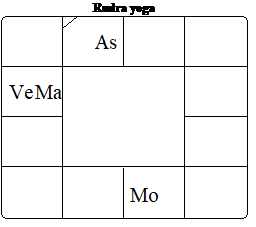
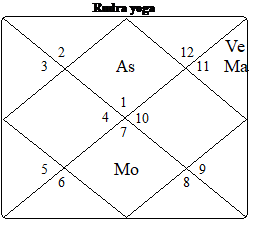
In this chart, Rudra yoga forms by mutual aspects between Moon + Venus (sign aspects), as well as Mars + Moon. Now, when the Shoola dasa of Taurus comes, two Rudra yogas will be activated fully and thus the native’s death will be likely during this nine-year period, i.e. between the ages of 9 and 18. This is because all the participants in Rudra yoga aspect the Shoola dasa, in this case its lord Venus specifically. This is provided, of course, that longevity falls within the short term (0 to 36). If medium life were indicated for the native, then death would come during the Shoola dasa of Libra, as then all the Rudra yogas would be activated by that sign directly with Moon occupying it, and Venus/Mars aspecting it.
Dustha Marana Yoga
Dustha means “bad”, unusual, or very painful, while Marana refers to death. So this is not a good yoga to have considering that if it activates the Shoola dasa at the time of death, the native’s death is likely to be either violent, unusual, or painful. In the case of sudden death due to accident, gunshot, fall from a height, or other unusual situations, Dustha Marana yoga is frequently visible. It forms as follows:
Multiple malefics should join or aspect the 3rd from Arudha lagna, or its 8th, by rashi drishti. If the 7th house is stronger than the first, the Dustha Marana yoga forms from the 3rd and 8th from A7 as well.
Chart Illustration #2 – Example of Madhyayu
Male
March 19, 1950
20:49 EST
Rochester NY – USA
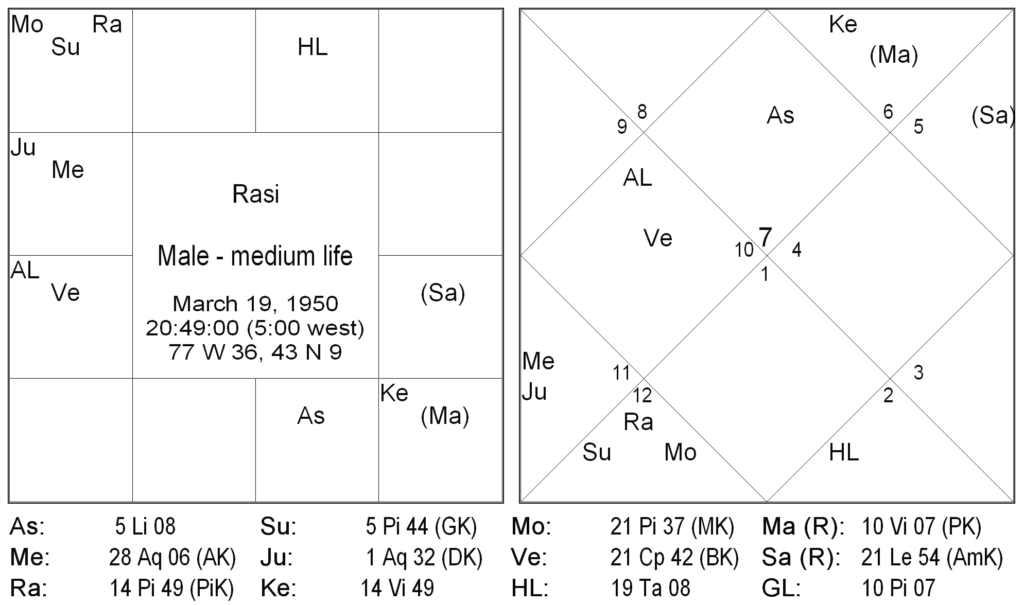
This is the chart of a person who contacted the Hepatitis C virus while traveling in a foreign country. From the point of the disease’s onset in mid-1996, the native gradually diminished in strength until he finally died on March 15, 2008 just before his 58th birthday. His death was rather violent and unusual, i.e. vomiting blood en route to the hospital, and dying on the hospital operating table due to loss of blood.
Determining the Term of Longevity
Of the three approaches given previously, let us try the method of three pairs in seeing why this individual was granted the middle term of life:
Lord of lagna = Venus = moveable sign = long life
Lord of 8th = Jupiter = fixed sign = short life » term is medium
Lagna = Libra = moveable sign = long life
Hora Lagna = Taurus = fixed sign = short life » term is medium
Moon sign = Pisces = dual sign = medium life
Saturn = Leo = fixed sign = short life » term is long
Note that when the lord of the 8th is the same planet as the lord of the 1st, as in Aries and Libra ascendants, then take the lord of the 8th from the 8th for the 8th lord.
Two out of three pairs indicate medium life, and so that is the term allowed for the native. There are no considerations warranting either increase or decrease in the term (Kaksa Vriddhi or Kaksa Hrasa), and so the medium term stands.
Other Considerations
- The native was born just one day after a full solar eclipse, and thus the Sun and Moon are afflicted by the nodes. Further, the strong retrograde maraka lord Mars aspects the luminaries, thus weakening the general health and ultimately longevity. Mars’ aspect to the Moon also causes Rudra yoga in this chart.
- The ascendant as well as the ascendant lord both come under the aspect of a strong, Rx Saturn. While Saturn can cause Kaksa Hrasa when in aspect to the ascendant, its tendency to diminish longevity is lessened in this chart due to his being a strong, benefic yogakaraka. Saturn should be a functional malefic for the chart in order to cause Kaksa Hrasa, as was shown in Chart illustration #1.
- The Arudha lagna is Capricorn, while multiple malefics aspect the 3rd This causes Dustha-marana yoga, and thus the cause of death is loss of blood due to the Mars/Moon combination with the nodes.
- Further, at the time of the native’s death, Saturn and Ketu were transiting in the sign of Leo, which is 8th from the Arudha lagna. Their rashi drishtis thus fell on the AL, the lagna lord, as well as the lagna. In addition, on the day of death, the Moon and Mars transited in the sign of Gemini thus activating the Rudra yoga, and causing Rudra yoga themselves. The effects of this combination will be even clearer when the Shoola dasa is examined below.
- The Arudha of the 7th house is Aquarius, from which the 8th house is afflicted by Mars and Ketu. The sign of the Atmakaraka is also Aquarius, and thus the dasa of either Pisces/Virgo or of Aries is certain to bring forth the death of the native.
Determination of Rudra and Mahesvara
Between 2nd lord Mars and 8th lord Venus, Mars is Rudra in this chart due to his joining another planet (Ketu). Further, as the ascendant lord, Venus is not disposed to be an agent of death, but rather promotes life.
The 8th from Atmakaraka is Virgo, yet has Ketu in it. Thus, Mahesvara is not the 8th lord, but rather the 6th lord from AK which is the Moon.
Dasa Periods at the Time of Death
Vimsottari dasa: The native was running the dasa period of Mars/Mercury/Jupiter at the time of death. Note that Mars is a most powerful maraka in this chart ruling the 2nd and 7th, and thus since his dasa period operated during the middle frame of life, i.e. from Nov. 25, 2003 to Nov. 25 2010, he was sure to bring death during his dasa.
Mercury is the 12th lord in the chart, while Jupiter is the malefic 3rd and 6th lord, and thus their Antaradasha and Pratyantaradasas were in operation. The major period of a maraka, and sub-periods of 6th, 8th, or 12th lords bring about death, as per the guidelines given above.
In this case, the root cause of death was disease of the liver, which comes to the 5th house of the astrological chart, as well as the planet Jupiter. Since Mercury and Jupiter are functional benefics, why did they not protect the native during their sub and sub sub-periods? Note here that, apart from their lordships, Mercury disposits Mars and Ketu into the 5th house, while Jupiter brings Sun/Rahu/Moon there by dispositorship as well. Thus not only is the liver very afflicted in this chart, but death itself comes by way of the sub-periods of the planets causing affliction to it.
Shoola Dasa
Since the term of longevity granted is medium, the Shoola dasas that will bring about death are from the 5th house to the 8th house, that is, of Aq, Pi, Ar, and Ta in this chart. Which of these will bring death? If the correct Shoola dasa can be found, then death shall be timed to within a nine year period, and then to within a nine month period if the correct Antaradasa is found. Note as follows the likely periods:
- Pisces Shoola dasa runs from age 45 to 54, and is a likely dasha for initiating death. Pisces is 3rd from the AL, and is also afflicted by a terrible Rudra yoga. Moon is also in Pisces in weak Paksa bala, and further is Mahesvara. Why then did he not die during that period instead? Note as follows:
- The Aries Shoola dasa is very likely also to bring death, as Aries is the maraka 7th house, a very strong factor. Also, its lord is Mars who further damages longevity being Rudra and also involved in the Rudra yoga. In the case of Aries, since the dasa sign as well as its lord are Marakas, then it will carry more weight in deciding the time of death than the sign Pisces which is not in a maraka house (6th).
- Perhaps the over-arching reason why death occurred in the Aries dasa (age 54 to 63) rather than Pisces, as during the Pisces dasa, the Vimsottari dasa running was of the Moon, while the Moon is not a maraka lord in this chart.
- The Shoola dasa sub-period at death was of Pisces, which is directly the 3rd from AL, and since the Moon is there afflicted by Mars and the nodes, Rudra yoga applied fully at this point in time: between Dec. 21, 2007 and Sep. 22, 2008.
The above is a sketch of some of the most essential elements in longevity determination. The subject, however, is vast and thus the serious student wishing to fine-tune the techniques of longevity and the timing of death should approach the subject in all the astrological classics as a serious and dedicated study. Longevity is also a subject, which needs to be dealt with carefully. Due to a natural fear of mortality in all persons, the information concerning death and longevity should be kept by the astrologer as private unless the subject or his relatives are ready to hear such information.


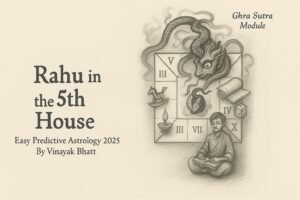
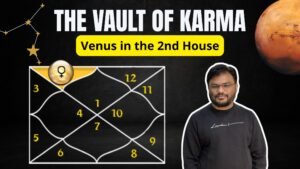
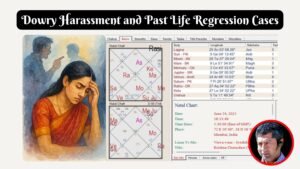
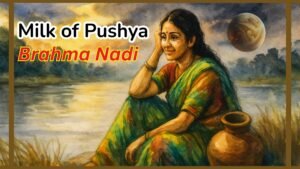

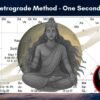
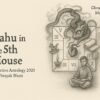

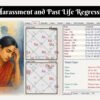
Leave a reply
You must be logged in to post a comment.